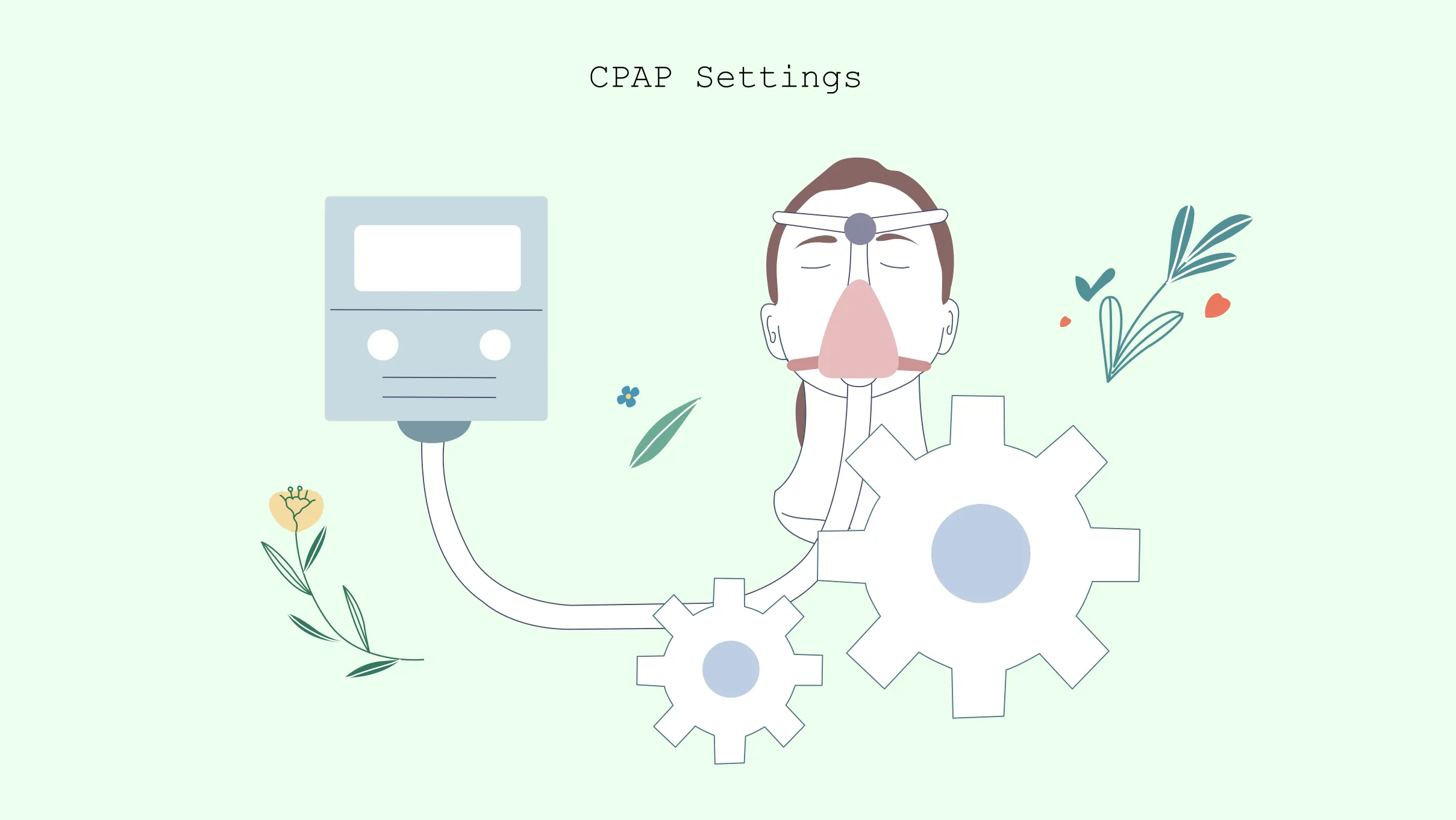What Should My CPAP Pressure Setting Be?
Written by

Medical reviewed by


CPAP machines have revolutionised the treatment of sleep apnea and other sleep disorders and enhanced users’ sleep quality. However, to get the best benefits of this treatment method, it is important to adjust the CPAP settings per individual users’ unique needs. Doing so ensures greater breathing comfort and makes the users feel entirely relaxed and rejuvenated after waking up.
Have you been using the CPAP machine and need clarification on the right pressure settings? Sleep Guides India aims to provide detailed information about CPAP pressure settings. You will also learn about the benefits of using the right pressure.
What Do CPAP Pressure Settings Mean?
The level of air obstruction experienced by people suffering from sleep apnea varies from person to person. The CPAP machines deliver pressurised air directly to the air passageways to help normalise breathing.
The CPAP pressure settings can range between 6 and 14 cm H2O, with most machines having an average setting of 10 cm H2O. However, the average pressure for CPAP changes according to the level of air obstruction and other physical and health conditions of the patients.
What Should My CPAP Pressure Be?
The right pressure settings of CPAP machines are different for each user. The most important of these is the apnea-hypopnea index (AHI), which determines the air obstruction you face. Most sleep specialists use the AHI details along with a CPAP titration study (an overnight sleep study) to decide the CPAP settings for OSA patients.
Other factors that impact the pressure settings include the age and gender of the patient, their weight and BMI, and other health issues they might be suffering from. Thus, the CPAP settings for neonates will be significantly different from those of elderly patients. Similarly, the CPAP setting for asthma patients will vary considerably from those suffering from anxiety and depression. You need to seek the advice of your sleep consultant to choose the best CPAP settings.
Is My CPAP Pressure Too Low?
If you have been using the CPAP machine and are still facing difficulties in breathing normally, then the pressure setting of your machine may not be appropriate for you. In such cases, you might experience a sensation of being air-starved or might even start snoring loudly. You may also feel tired and even start gasping for air during the night. The latter may lead to problems like bloating, excessive belching, and discomfort due to gases.
If you are experiencing any of the above symptoms, it is advisable to first talk to your sleep specialist, get a CPAP titration study done (if done before 1 year) and then change the common CPAP settings to adjust the pressure as required.
Is My CPAP Pressure Too High?
If the CPAP starting settings are adjusted for too high pressure, it may make you uncomfortable and disrupt your sleep at night. A high-pressure setting may make your mouth, nose, and airways dry, making it difficult for you to fall asleep. You might also experience aerophagia, where you start gulping in air through and sending it directly to your stomach. You may also have a burning sensation in your mouth and throat, and you may experience daytime fatigue, hearing issues, or fluid leaking from your ears.
If experiencing the above, it is recommended to directly talk to your sleep specialist, undergo a CPAP titration study if required and then change the pressure of the CPAP machine. The change of your CPAP machine pressure should always be guided by the doctor and never regulated on your own.
Consequences of Improperly Set CPAP Pressure
As mentioned before, getting the basic CPAP settings right can offer a wide range of benefits, including enabling you to enjoy a good night’s sleep and relieving problems like sleep apnea. However, if CPAP settings are not properly set, several issues can arise, impacting the effectiveness and comfort of the therapy. Here are some potential consequences:
- Inadequate treatment: If the CPAP pressure is set too low, it may not effectively keep the airway open during sleep, leading to persistent sleep apnea events. This means the individual may continue to experience interruptions in breathing, decreased oxygen levels, and disrupted sleep, resulting in ongoing symptoms and potential health risks associated with untreated sleep apnea.
- Insufficient oxygenation: If the CPAP pressure is too low, it may not provide adequate airflow and oxygenation. This can result in lower blood oxygen levels during sleep, leading to oxygen desaturation and potential complications, particularly for individuals with underlying respiratory or cardiovascular conditions.
- Persistent snoring: Snoring is often a prominent symptom of sleep apnea, and inadequate CPAP pressure may not effectively eliminate or reduce snoring. This can disturb the sleep of the individual using CPAP and their bed partner, potentially causing discomfort and compromising the effectiveness of the therapy.
- Discomfort and poor compliance: If the CPAP pressure is set too high, it can cause discomfort, difficulty in exhaling against the pressure, or feelings of claustrophobia. This can lead to poor compliance, as individuals may be less inclined to use the CPAP device consistently if it is uncomfortable or causes distress.
- Mask leakage: Incorrect CPAP pressure settings can contribute to mask leakage, where air escapes around the mask seal. This reduces the effectiveness of therapy as the intended pressure may not reach the airway properly. Mask leakage can lead to dryness, noise, irritation, and disruptions in sleep quality.
- Nasal congestion and dryness: Inappropriate CPAP pressure can cause nasal congestion, dryness, or irritation. If the pressure is too high, it may result in excessive air pressure in the nasal passages, leading to discomfort and nasal congestion. With insufficient pressure, individuals may experience increased occurrences of sleep apnea symptoms like snoring, gasping, choking, and interrupted sleep. These symptoms can persist, causing sleep fragmentation and contributing to daytime fatigue and impaired cognitive function.
- Noncompliance and discontinuation of therapy: When CPAP settings are not properly adjusted, individuals may experience discomfort, inadequate symptom relief, or ongoing sleep disruptions. This can lead to noncompliance, where individuals do not consistently use the CPAP device as prescribed. Noncompliance or discontinuation of therapy can result in the persistence of sleep apnea symptoms and related health risks.
It is crucial to work closely with a healthcare professional to ensure proper CPAP pressure settings. Regular follow-up appointments and adjustments are necessary to optimise therapy effectiveness and address any issues that may arise.
How To Change CPAP Pressure Yourself
If you are experiencing any discomfort or symptoms, it might indicate that the CPAP settings are not right. In such cases, it is advisable to consult your sleep specialist. Changing the settings on your own may cause the pressure to be set too high or low, making the device ineffective.
Conclusion
Having the correct pressure CPAP settings is essential to enjoy the benefits of this much-recommended method. It is advisable to consult a sleep specialist to decide the right CPAP pressure setting on the basis of appropriate CPAP titration study data to ensure maximum comfort for the patients.
FAQs
What does a CPAP setting of 5 mean?
Mild sleep apnea is indicated by a reading of 5–15 apnea occurrences. The range 15–30 is regarded as moderate sleep apnea. AHI of 30 or above is regarded as serious sleep apnea.
What do CPAP numbers mean?
The AHI value reveals how many apnoea and hypopnea events—or instances in which you stop breathing—you have each hour. AHI values under 5 are regarded as normal. Mild sleep apnea is indicated by a reading of 5–15 apnea occurrences. The range of 15–30 is regarded as moderate sleep apnea. AHI of 30 or more is regarded as extreme sleepiness.
How do you know if CPAP pressure is too low?
After using a CPAP machine, if you still feel sleepy or unrefreshed in the morning, it’s possible that your airways aren’t open enough with CPAP thus not receiving enough oxygen to stay open.This may lead to a persistent apnoea.
How do I know if my CPAP pressure is too high?
Breathing difficulties are one of the main signs that your CPAP pressure may be too high. It might be necessary to lower your prescribed pressure if you have trouble exhaling despite it.
people like this article
Written by

Medical reviewed by




